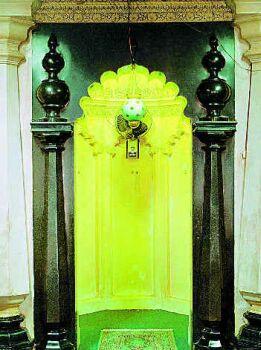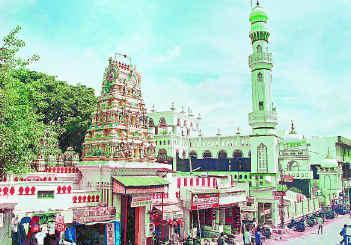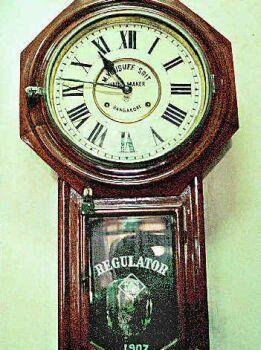Bangalore, KARNATAKA :
A cluster of shrines of all denominations dots the road that has not seen a single instance of communal violence.

IT IS every bit a spot Mahatma Gandhi dreamed of. A stretch on Old Poor House Road in the Cantonment area, behind Bowring Hospital, has a church, two temples, and four mosques. As the country enters its 57th year of Independence at a time of competitive communalism, the businessmen on O.P.H. Road have insulated this busy street from the influence of zealots.
“We live like brothers here. We sit across the table and sort out the differences, if there are any,” says Syed Masood, Chairman of the Jumma Masjid Trust, which owns 290 shops on O.P.H. Road. The mosque, which has a 90-foot minaret, was built in 1790 with materials supplied by Tipu Sultan from Srirangapatna. The magnificent granite structure can accommodate up to 5,000 people for namaz. The frame of its mehrab is carved out of a single block of black granite. The serene prayer hall has black stone pillars. The other four mosques are Masjid-e-Azam, Masjid-e-Bewarpawan (Merchant’s Mosque), Lal Masjid (1845), and Masjid-e-Lababeen.
The Jumma Masjid also has a clock that has been ticking for 97 years now. Its late Imam, Abdul Hafeez Junaidi, had the distinction of being the only imam in India to have conducted prayers for 50 years in a row. Having played no mean role in promoting peace, he is still revered by the businessmen of the area.
To the left of the mosque stands the Lakshminarasimha Swamy Temple. The sanctum sanctorum was earlier a small mandapam with the beautiful deity carved out of granite, said to date back to early 19th Century. Doddanna Shetty (1840-1921), well-known philanthropist and founder of S.L.N. Charities, drawn to the modest shrine as a boy, developed it into a full-fledged temple in 1910.

Later, the late Mayor, C.P. Deenadayalu Naidu, took over management of the shrine. After his time, the mantle fell on his nephew, V.P. Chengalarayalu Naidu, in 1986. The latter says even on December 6, 1992, when the area was tense after the Babri Masjid was razed in Ayodhya, the area, on which a curfew was clamped, remained free of violence. “I rushed to the temple on hearing the news that day. The businessmen told us that nothing untoward would happen,” he says.
The temple attracts a large number of devotees from the surrounding villages on Holi, not to speak of hundreds of Christians who throng St. Mary’s Basilica during Mary’s Feast in September. Incidentally, a few feet away from the temple is St. Paul’s Church, which has its entrance at the Bowring Hospital end.
To the right of the Jumma Masjid is the 101-year-old Sri Venugopalaswamy Temple, run by the Reddy Bhoomi Kalyana Kula Brundam. The garba griha here has Rukmini, Venugopala Swamy, and Satyabhama as deities. Built in 1902, it used to have Sugreeva as the presiding deity earlier. When a shrine at Vannarpet (Viveknagar) was dismantled, the idols of Rukmini, Venugopala Swamy, and Satyabhama were shifted to this temple by members of the Reddy Bhoomi Kula community.
Says V. Krishnamurthy Shastri, an astrologer who has been working here for the past seven years: “Till recently, oil for the lamps and flowers for puja were supplied by Muslims. When they take out processions, they don’t trouble us. On special occasions, the traders go out of their way to help us.”
T.H. Yang, a Chinese trader, who makes special shoes for disabled persons, finds it hard to be unaffected by the friendly nature of the people in the area. He has been doing business here (his shop is called C.H. Yong and Company) for 51 years. His father opened the establishment in 1933 and he took over in 1952.

Communal harmony had always existed in the 15-odd villages surrounding Cantonment, even before General Wellesley trooped in with his soldiers in 1809 after conquering Srirangapatnam. The burrah sahebs and memsabs, as the Europeans were called, did not attempt to alter this situation either.
“The Assigned Tract (Cantonment) had a charm of its own, which can hardly be described. The area is an agglomeration of people of different tongues — both Indian and European — welded into one community by the common economic interests. Here met East and West in a most dynamic focus. A warm handshake, a courteous salaam, and a kindlynamaste greeted the citizens. Its population, in 1891, was 1,00,81 as against 80,285 in the city,” says Fazlul Hassan, historian, in his bookBangalore Through The Centuries.
Although vivacious shoppers from Europe and savvy merchants dominated life here, lending its own character, the Cantonment area did catch the spirit of nationalist fervour. During the height of the Khilafat movement in 1921, it reverberated with slogans of Swaraj. Merchants and philanthropists supported the movement and a public meeting was held at the Idgah Maidan in Benson Town which was addressed by Mahatma Gandhi, Moulana Abul Kalam Azad, and Moulana Shoukat Ali. In a fiery speech, Moulana Mohammed Ali said: “The power behind the chakra gun is so effective that a single shot fired from Bangalore is sufficient to destroy Manchester.”
Traders from Commercial Street sent bales of foreign cloth to the sprawling maidans of Blackpalli (Shivajinagar) and the Muslim orphanage on Dickenson Road, which were set on fire. Osman Sait, a wealthy merchant, sold all his property to meet the expenses of Khilafat movement in the area and to start nationalist educational institutions and publications.
Today, not many remember the heady days and valorous deeds that eventually won us Independence. When our country now battles religious turmoil from within, communities like those on O.P.H. Road are an inspiring example.
V. RAMESH
source: http://www.thehindu.com / The Hindu / Home> Metroplus Bangalore / by V. Ramesh / Thursday – August 14th, 2003








